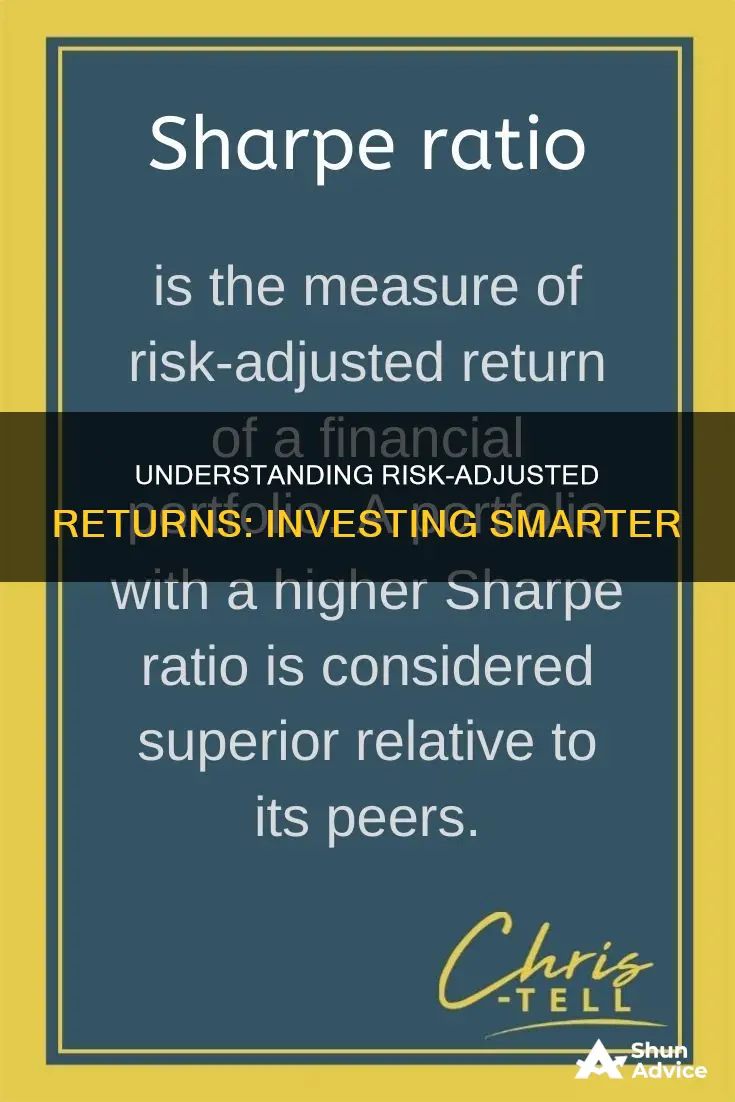
Risk-adjusted returns are a financial metric that assesses the profitability of an investment relative to the amount of risk taken. In other words, it's a way of measuring the returns of different investments with different levels of risk against a benchmark. This allows investors to compare the risk between two or more investments and consider the associated risk when contextualising returns.
| Characteristics | Values |
|---|---|
| Definition | A financial metric that assesses the profitability of an investment relative to the amount of risk taken |
| Purpose | To contextualise returns by considering the associated risk |
| Calculation | A calculation of the profit or potential profit from an investment that considers the degree of risk that must be accepted to achieve it |
| Comparison | Allows you to compare the risk between two or more investments |
| Benchmarking | Examines the changes in the risk-free rate and compares actual returns with those of a benchmarked index |
| Variability | The risk-adjusted return can vary from one investment to another, as many external factors affect the level of risk |
| Application | Applied to individual stocks, investment funds, and entire portfolios |
| Measurement methods | Sharpe and Treynor ratios, alpha, beta, and standard deviation |
What You'll Learn
- Risk-adjusted returns are a financial metric that assesses the profitability of an investment relative to the amount of risk taken
- Risk-adjusted returns can be applied to individual stocks, investment funds, and entire portfolios
- Risk-adjusted return metrics allow you to compare the risk between two or more investments
- Risk-adjusted returns can be measured using the Sharpe and Treynor ratios, alpha, beta, and standard deviation
- Risk-adjusted returns are useful for comparing various individual securities and mutual funds, as well as a portfolio

Risk-adjusted returns are a financial metric that assesses the profitability of an investment relative to the amount of risk taken
Risk-adjusted returns are calculated by measuring the profit or potential profit from an investment and comparing it to the degree of risk that must be accepted to achieve it. The risk is usually measured against a virtually risk-free investment, such as US Treasuries. This calculation can be applied to individual stocks, investment funds, and entire portfolios.
There are several methods for evaluating risk-adjusted performance, including the Sharpe and Treynor ratios, alpha, beta, and standard deviation, each yielding slightly different results. These metrics allow investors to compare the risk between different investments, examine changes in the risk-free rate, and compare actual returns with those of a benchmarked index.
Risk-adjusted returns are particularly useful when comparing the performance of two investments or evaluating the returns of a portfolio. By considering both the returns generated and the amount of risk taken, investors can make more informed decisions about the relative attractiveness of different investment opportunities.
Equilibrium GDP: Saving, Investment, and their Symbiotic Relationship
You may want to see also

Risk-adjusted returns can be applied to individual stocks, investment funds, and entire portfolios
Risk-adjusted returns are a financial metric that assesses the profitability of an investment relative to the amount of risk taken. In other words, it's a measure that contextualises returns by considering the associated risk. This means that higher potential returns should come with higher risk. Risk-adjusted returns can be applied to individual stocks, investment funds, and entire portfolios.
Risk-adjusted returns are calculated by measuring an investment's return and considering the degree of risk taken to achieve it. The risk is measured in comparison to a virtually risk-free investment, usually US Treasuries. The risk calculation is expressed as a number or a rating, depending on the method used.
There are several methods for evaluating risk-adjusted performance, including the Sharpe and Treynor ratios, alpha, beta, and standard deviation. Each method yields a slightly different result. Risk-adjusted returns allow investors to compare the risk between two or more investments and examine changes in the risk-free rate.
By considering risk-adjusted returns, investors can make more informed decisions when comparing the performance of different investments or checking the returns of their portfolios. It helps to assess whether the returns generated are worth the amount of risk taken.
Smart Ways to Double Your Money with a $50 Investment
You may want to see also

Risk-adjusted return metrics allow you to compare the risk between two or more investments
If an asset shows a lower risk than the overall market, any return on the asset above the risk-free rate will be considered a gain. Risk-adjusted return metrics offer several benefits. They allow you to compare the risk between two or more investments, examine changes in the risk-free rate, and compare actual returns with those of a benchmarked index. The risk-adjusted return can vary from one investment to another, as many external factors affect the level of risk.
There are several methods for evaluating risk-adjusted performance, such as the Sharpe and Treynor ratios, alpha, beta, and standard deviation, with each yielding a slightly different result. Risk-adjusted returns are applied to individual stocks, investment funds, and entire portfolios.
Corporations' Investment Strategies: Debt and Equity Explained
You may want to see also

Risk-adjusted returns can be measured using the Sharpe and Treynor ratios, alpha, beta, and standard deviation
Risk-adjusted returns are a financial metric that assesses the profitability of an investment relative to the amount of risk taken. In other words, it's a measure that contextualises returns by considering the associated risk. This means that higher potential returns should come with higher risk. Risk-adjusted returns can be applied to individual stocks, investment funds, and entire portfolios.
There are several methods for evaluating risk-adjusted returns, including the Sharpe and Treynor ratios, alpha, beta, and standard deviation. Each of these methods yields a slightly different result.
The Sharpe ratio is a measure of risk-adjusted return that calculates the excess return (or risk premium) per unit of volatility. It is calculated by subtracting the risk-free rate from the expected return of the investment and then dividing by the standard deviation of the investment's returns.
The Treynor ratio is another measure of risk-adjusted return that calculates the excess return (or risk premium) per unit of systematic risk. It is calculated by subtracting the risk-free rate from the expected return of the investment and then dividing by the beta of the investment.
Alpha is a measure of the abnormal return on an investment, which is the return that is not explained by the market risk. It is calculated by subtracting the expected return (based on the investment's beta) from the actual return.
Beta is a measure of the volatility or systematic risk of an investment relative to the market. It is calculated by regressing the returns of the investment against the returns of the market and measuring the slope of the regression line.
Standard deviation is a measure of the volatility or total risk of an investment. It is calculated by taking the square root of the variance of the investment's returns.
Maximizing Investment Returns: Increasing Risk for Betterment
You may want to see also

Risk-adjusted returns are useful for comparing various individual securities and mutual funds, as well as a portfolio
Risk-adjusted returns are a financial metric that assesses the profitability of an investment relative to the amount of risk taken. In other words, it's a measure that contextualises returns by considering the associated risk. This means that higher potential returns should come with higher risk. Risk-adjusted returns are applied to individual stocks, investment funds, and entire portfolios.
There are several methods for evaluating risk-adjusted performance, such as the Sharpe and Treynor ratios, alpha, beta, and standard deviation, with each yielding a slightly different result. The concept is used to measure the returns of different investments with different levels of risk against a benchmark. If an asset shows a lower risk than the overall market, any return on the asset above the risk-free rate will be considered a gain.
Unlocking Private Equity: A Guide to Smart Investing
You may want to see also
Frequently asked questions
A risk-adjusted investment is a financial metric that assesses the profitability of an investment relative to the amount of risk taken.
Risk-adjusted investment measures the returns of different investments with different levels of risk against a benchmark.
Risk-adjusted investment allows you to compare the risk between two or more investments and examine changes in the risk-free rate.







